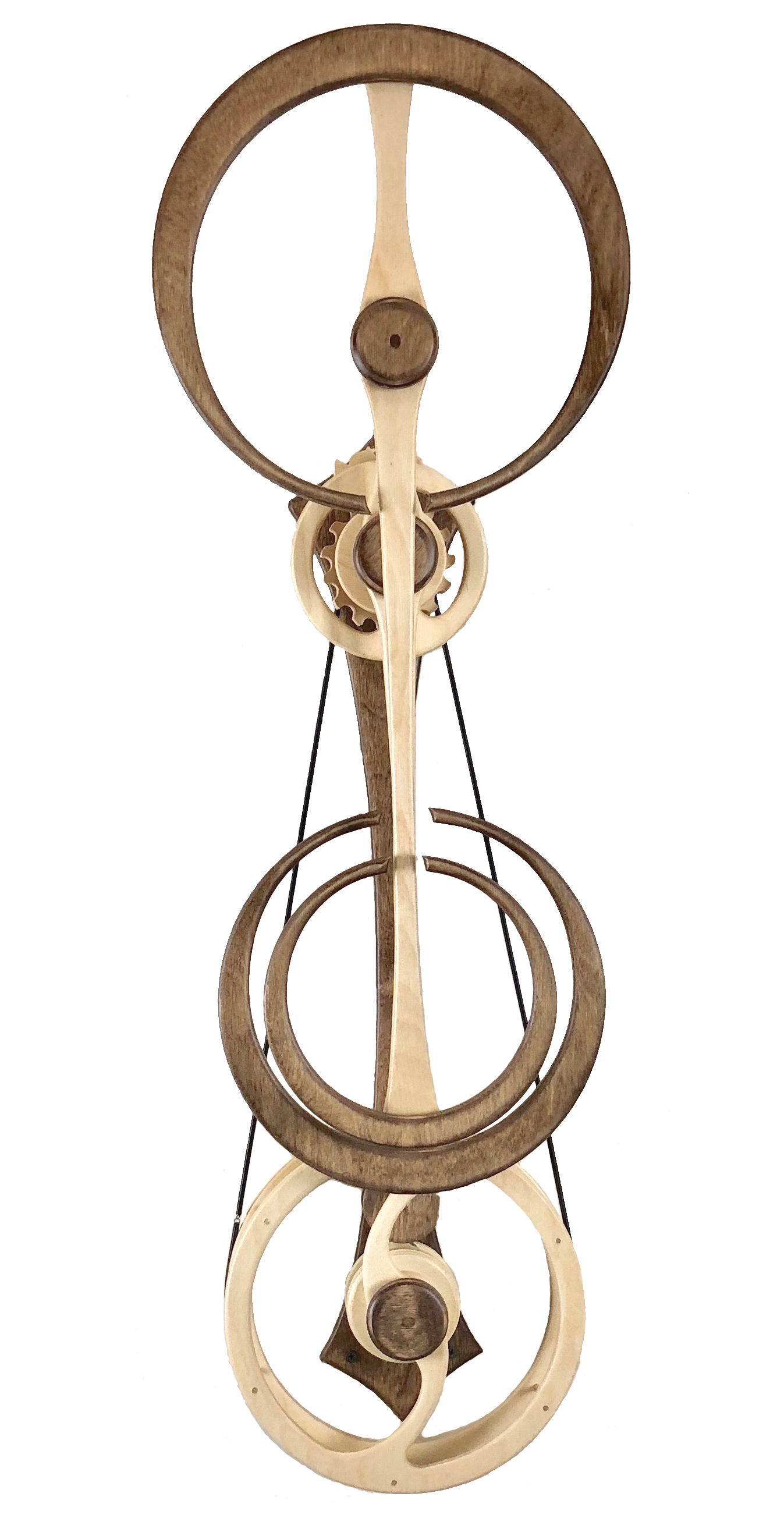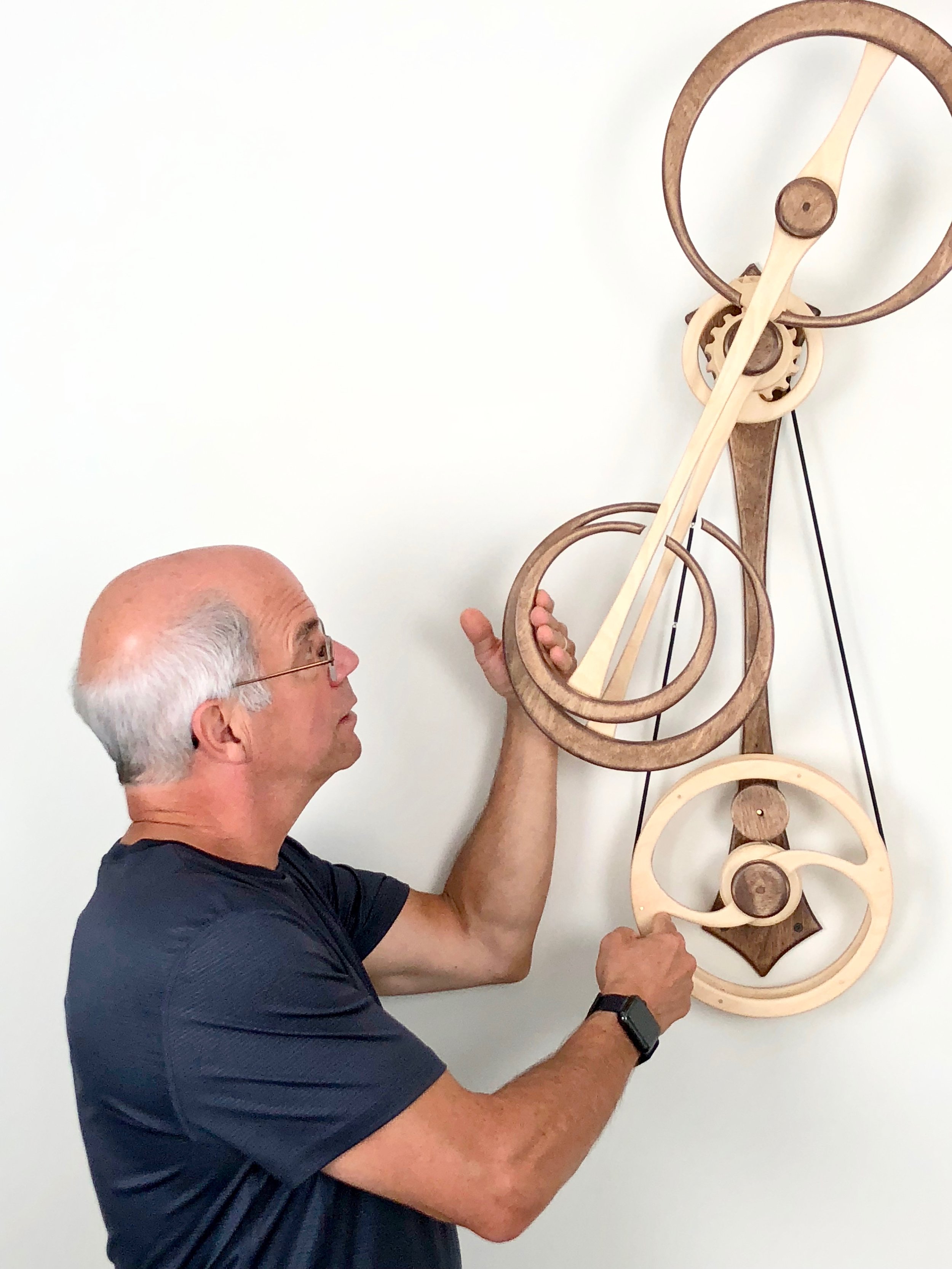Dance is a spring-driven kinetic sculpture by David C. Roy of Wood That Works. It runs for approximately 15 hours on a single winding. It is available in a signed and number edition of 36.
Chaos
Limited Edition of 95 • Size: 46" w x 40" h x 7" d • Approximate Run Time: 10 Hours
Price: $3500.00 - - opening bid - USA only
About Chaos
The history of Chaos spans decades. In 1979, I was playing with different shapes and balances looking for interesting patterns. A certain combination, when hand powered, created some fascinating motion. The back wheel would rotate around and the balancing front wheel would just hang there. Then, for seemingly no reason the front wheel would start swinging erratically changing the motion of the back wheel. This was my first experience with unpredictable or random behavior. I didn’t know what was going on but I liked it. I added a drive mechanism and a sculpture named Serpentine was born.
Several decades and many sculptures later a fascination with the graphic properties of fractals led me to a book entitled Chaos by James Gleick. In a section on simple systems like pendulums and double pendulums I found this paragraph:
“Unpredictability was only the attention-grabber. Those studying chaotic dynamics discovered that the disorderly behavior of simple systems acted as a creative process. It generated complexity: richly organized patterns, sometimes stable and sometimes unstable, sometimes finite and sometimes infinite, but always with the fascination of living things.”
I was reminded of Serpentine and its changing patterns. Serpentine was a type of double pendulum. I wanted to explore this more. I had new tools, materials and nearly 40 years of experience and this time I wanted to understand the motion and, if not control it, at least influence it.
I’ve spent much of this past year playing with and studying double pendulum motion. I tried several different forms before settling on 2 stylized pendulums combined into a double pendulum. Other forms could work but I settled on the simplest shape so the motion would be the focus. The big breakthrough came when I created a mechanism that would push the pendulums only when they needed it otherwise allowing free swinging motion. As I refined the mechanism I found ways to fine tune it. For the last few months I’ve had many examples of Chaos performing in my studio. I tried many adjustments to see how each would influence the motion. Eventually I created a spreadsheet so I could track each change in an organized fashion. I’m finally ready to release Chaos into the wild. I hope you enjoy it as much as I do!
Winding Chaos:
Here is a video of David demonstrating how to wind Chaos.
About Sound:
Chaos has a wonderful wooden clicking sound. It is not silent but creates a melodic background accompaniment. I have video taped Chaos in action without the added musical background so you can hear as well as see the sculpture.
Déjà Vu
Duality
Limited Edition of 95 • Size: 33" in diameter • Approx. Run Time: 8 hours
Duality © 2017 • Edition SOLD OUT
About Duality:
When designing a kinetic sculpture many different types of balance need to be considered. This was especially true with Duality.
First there is visual balance. Marji (my partner, wife, art teacher) taught me about visual balance many years ago when I was working on my first sculptures. Basically it is trying to achieve balance in the appearance of the sculpture. Symmetrical designs are visually balanced but can be boring while asymmetrical designs are harder to balance but usually more interesting.
Second, there is simple balance. Here each mechanical part of a kinetic sculpture must be either in balance or off balance by a precise amount as related to gravity. Absolute precision in this area is impossible to achieve when working in wood but it is essential in my design to have a clear understanding of the tolerances available in each design.
And lastly, I work with what I call patterning balance. I created this term to define the balance I need to achieve between the complexity of a motion and the designs of the individual components (wheels, levers, etc.) within a sculpture. More complex patterning wheels usually require a more restrained motion than less complex wheels to prevent the sculpture from becoming visual chaos. Duality has what I consider a more complex asymmetrical wheel design. In order to fully comprehend the patterns created, the mechanism has to move the wheels in a more predictable way. Alternatively a sculpture like Infinity has symmetrical wheels so I used a more random and unpredictable mechanism to move it. After designing the wheel for Duality I needed to experiment with the various motions I can create to establish the visually most exciting combination. Once I achieve that patterning balance, I have a sculpture!
Detail Photos of Duality:
Kindala - Stars
Limited Edition of 24 • Size: 33 " diameter x 6 "d • Approx. Run Time: 12 hours
Kindala - Stars © 2017 • SOLD OUT
About the Kindala Series:
A type of pattern creation that has repeatedly frustrated me is one with wheels moving in the same direction. I knew there was some great potential in this area because I could see glimpses of new patterns when I rotated wheels by hand and on the computer screen. The challenge was to make the wheels move slowly but at different and constantly changing speeds with the goal of producing a kaleidoscopic effect. My first successful attempt evolved into a large fairly complicated one-of-a-kind sculpture called Starscape made in 2007. For the next 8 years or so I dabbled with ideas on the computer and developed several wheel patterns but the mechanism continued to escape me, until last year.
I found that by using elements of the mechanisms I had designed for Sky Quest, Dimensions and Infinity I could make a new mechanism that began to produce the motion I wanted. I spent most of 2016 studying and tuning the mechanism, exploring its limits and making it reliable. It turns out making wheels move slowly but not stopping was a challenge but I succeeded.
Now that I have the mechanism there is a whole world of new patterns to discover. I'm very excited by the potential. So much so that I've decided to produce different Kindala designs in very small editions so I can keep exploring.
Why Kindala? Kindala is a manufactured word I created by combining Mandala and kinetic. I thought this series needed a distinctive moniker. Every design is a circular design like a mandala and they all move but each has visual distinctions in the wheel design.
About Kindala - Stars
The Kindala - Stars wheel has a relatively simple spoke form set at a precise angle to create a dynamic star burst pattern. During a large part of the cycle the pattern expands peacefully and then for a brief period crescendos into an explosive pattern before settling down to the quiet pattern again. Watch the video and notice the radiating stars.
Detail Photos of Kindala - Stars











